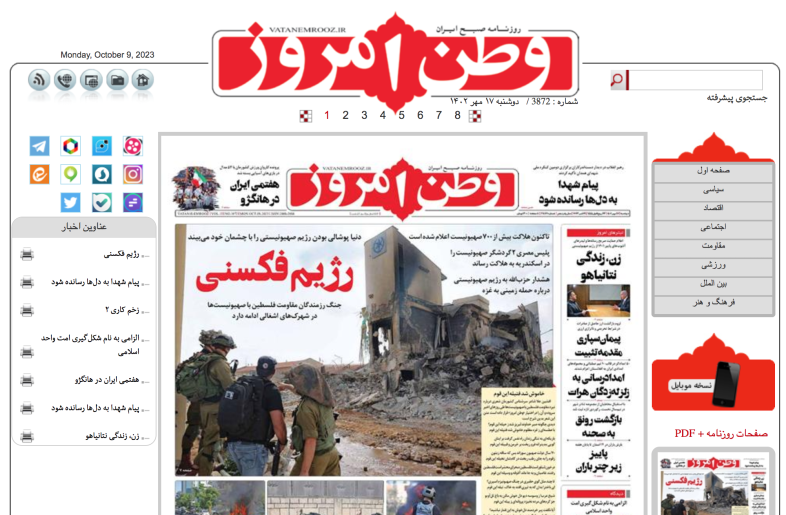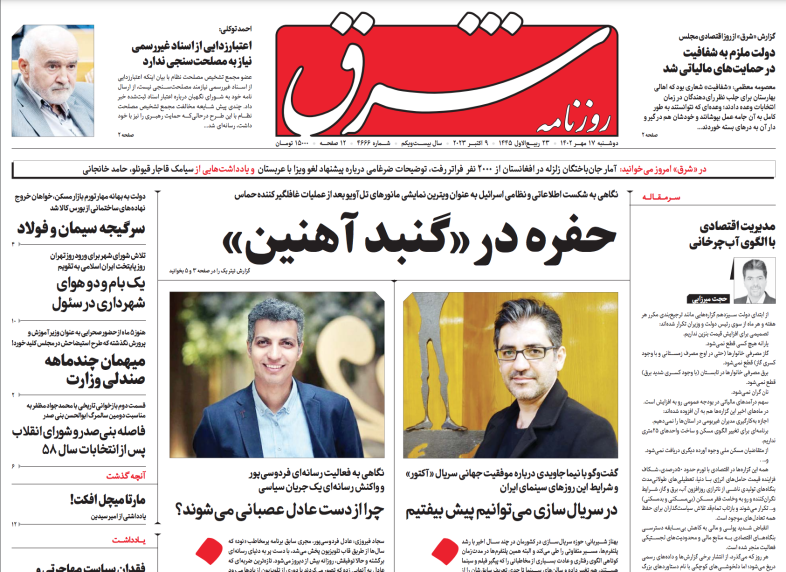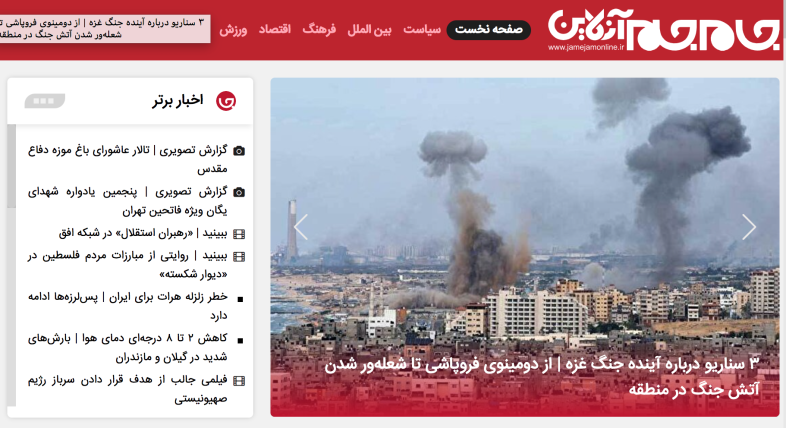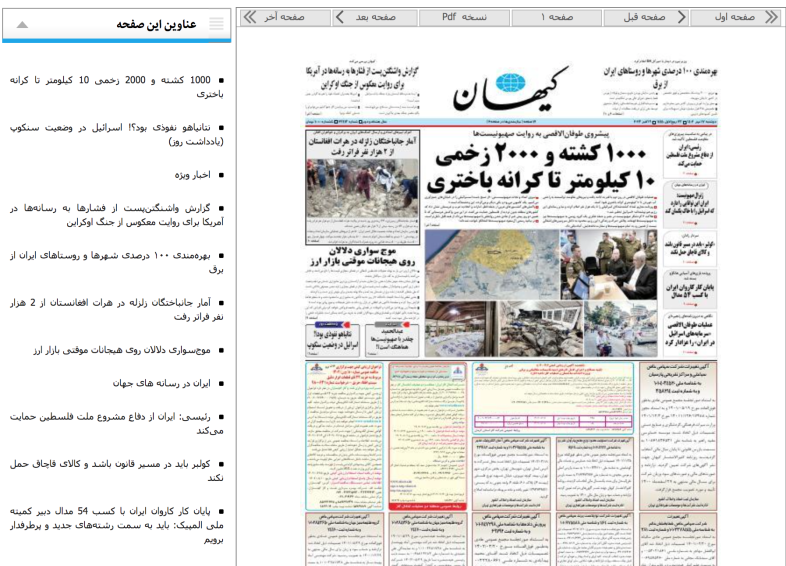Iran’s authorities have been polishing up the art of political propaganda for nearly 45 years of the Islamic Republic’s existence. After the Islamic revolution in 1979 Iranian media quickly found itself under the strict and watchful eye of the Ministry of Culture and Islamic Guidance, leaving the editorial boards little choice but to only print the information which has faithfully adhered to the ‘official party line’. Occasionally, however, the so-called ‘reformist’ publications are trying to somewhat soften the wording used in their articles.
As expected, the press in Iran was wildly enthusiastic about Hamas’ barbaric attack on Saturday. The newspaper “Sobh-e No” (“New Morning”) came out with the headline “The Beginning of the End of the Oppressive Regime”. The newspaper “Vatan-e Emrooz” (“Homeland Today”) printed an article on its front page titled “Humiliation of Israel,” in which the author describes the ‘swift’ operation of Palestinian ‘freedom fighters’, which became the ‘biggest surprise to Israel over the past several decades’. In another article, the same publication engages in a one-sided historical review, repeating well-known clichés about colonisation, occupation, decades of oppression, and compares Saturday’s events to the fall of the Berlin Wall: “After the fall of the Zionist wall [referring to Palestinians breaking into the Israeli side of the Israel-Gaza border fence], the reunification [of the Palestinian] nation will take place, just as it once did in Germany.” Many international observers have already noted that Iran’s primary interest in this operation was to disrupt a potential historic normalisation of ties between Saudi Arabia and Israel, and the authors did not forget to mention this in their article: “Enemies from the certain Arab countries, who intended to make a deal behind the Palestinians’ backs”.

“Hamshahri” (“Fellow Citizen”), the voice of the Tehran municipality, proudly published their article “Uprising of the Oppressed,” where the authors stated that “Operation Al-Aqsa Storm [also official Iranian sources only use the Arabic name for Jerusalem in Farsi, rather than its alternative, ‘Urushalim’] is a response to 70 years of oppression unleashed by the Zionist regime.”
The newspaper “Shargh” (“East”), which known for its cautious and relatively liberal editorial policy, has limited itself to presenting dry facts, such as stating the number of casualties on both Palestinian and Israeli sides, as well quoting neutral information from either Western or Israeli sources. The authors of the article “A Hole in the Iron Dome” on the front page of “Shargh” wrote that “the unexpected operation carried out by Hamas in Israel, which, according to the Israeli officials, has currently resulted in the deaths of at least 600 people, exposed significant flaws in Tel Aviv’s military security.” The publication uses neutral terms: “Israel,” “Palestinians,” “Israeli army,” “Hamas forces,” and so on.

The conservative publication “Jam-e Jam” (“Goblet,” a symbol of predicting the future in Iranian mythology) published an article titled “Unprecedented Resistance Operation in the Region”, praising the role of the “Palestinian youth in the resistance against the Zionist enemy” and stressing the role of the “revolutionary leaders” [Palestinian militants] in organising the attack. The newspaper claims that all the “achievements of the rebels” are the hard work of the Palestinian people, while the Islamic Republic merely demonstrates its support for those “fighting against the desecration of Jerusalem.” In another article, the publication states that “the most powerful countries in the world, including Britain, have bowed to the mighty wave of resistance and determination of the oppressed Palestinian people, acknowledging that this wave is likely to lead to a mass exodus of Jews from Palestine and the fall of the Zionist regime”.

The ultra-conservative newspaper “Kayhan” (“Universe”), the mouthpiece of the Iranian regime, published an editorial column about the “new realities of the region,” where authors describe the “heroic” breach of the fence at the Israeli-Palestinian border in Gaza during what the newspaper called “a historic shift from defense to offense against the occupiers”. Article’s authors also extensively analyse the “weakness,” “bewilderment,” and “indecisiveness” of the Israeli army.

The government’s newspaper “Iran,” published by the Islamic Republic News Agency (IRNA), released an article titled “Retribution for Violence,” praising Palestinian militants and emphasizing that Hamas owes its operation to the patronage of Hezbollah (which is known to be generously funded by Iran).
Furthermore, today nearly every Iranian newspaper printed images from pro-Palestinian rallies across the globe, and especially in major Western cities such as New York or London, trying to create the impression that the entire world stands in support of Palestine.
It is worth mentioning that the Iranian media based outside of Iran were hardly praising the Palestinian resistance – it was completely the opposite. This includes channels like Iran International, Manoto, or Radio Farda, the Persian language broadcaster at Radio Free Europe/Radio Liberty, which traditionally take a solid pro-Western and pro-American stance. These publications almost immediately emphasised Iran’s role in the attack and regime’s support for the Hamas militants. They also condemned Hamas’ heinous acts and called on the West to recognise that the sole “root of the problem” lies with the regime in Tehran.

